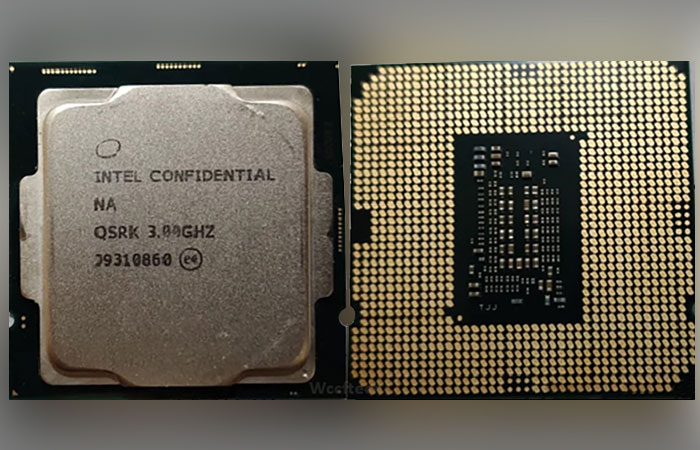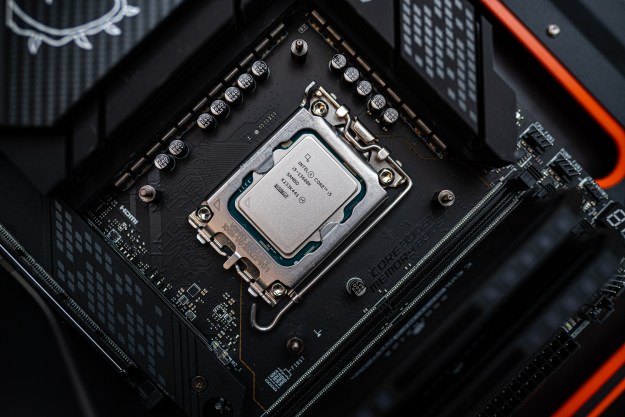
A picture of a CPU from Intel’s upcoming 10th-generation of Comet Lake S processors has been leaked, and the image has helped confirm some details of the next-generation chips. The near-production level quality of the snapped CPU suggests also that the next-generation processors are getting very close to their production run, which means we can expect samples to be going out to testers and reviewers in the near future, ahead of a projected April release.
Although far more people use Intel CPUs than AMD (the ratio is 4:1 according to the latest Steam Survey) the red team captured some serious momentum in 2019 with the launch of its Ryzen 3000 series. Intel countered with some excellent 10nm laptop parts, but with only a factory overclocked 9900K(S) to offer as an upgrade for desktop users, it is in dire need of something new and fresh. Comet Lake S should launch in the first half of 2020, and though it won’t be a major revolution of Intel’s hardware, it could evolve it enough to give the kind of bang for customers’ bucks that Intel needs to compete with AMD’s latest and greatest.
Rumored to launch in April 2020, Comet Lake S will be made up of the usual Core i3, i5, i7, and i9 CPUs, but there will be some notable changes. Thanks to the image unearthed by WCCFTech, we can confirm that the midrange 10400 will have a base clock of 3.0GHz. It also highlights how jam-packed the new chips’ PCBs are, suggesting that this really may be the last time Intel can tweak its 14nm process before it needs to transition to a new, trimmer process.
The CPUZ screenshot that accompanied the 10400 highlights that it’s a six-core part, with 12 threads (thanks to hyperthreading). Intel seems set to reinstate its simultaneous multi-threading feature for not just Core i9s and i7s, but Core i5s and i3s, too, right across its desktop portfolio. That will go a long way toward helping it compete with AMD’s Ryzen 3000 and potentially Ryzen 4000 CPUs, which will make their gradual debut on laptops and desktops throughout 2020.
Elsewhere in the Comet Lake S generation of CPUs, WCCFTech reports that the top-tier 10900K will have 10 cores and 20 threads, with a maximum all-core boost clock of 4.8-4.9GHz (less than the recently debuted 9900KS). It will also be able to hit 5.2GHz on a single core with Turbo Boost Max 3.0, and potentially even 5.3GHz with a new “Velocity” boost feature. This has required an increase in TDP to 125w though, suggesting heftier coolers will be required for Intel’s most powerful next-generation CPUs.
Throughout the rest of the range Intel will introduce six cores as a mainstream, mid-tier CPU default, and 4.0GHz+ turbo frequencies for just about every processor in the range. Cache has also seen an increase, which should further improve performance, though less dramatically than the boost we saw with Ryzen 3000 CPUs.
WCCFTech also reports that all new Comet Lake S processors (apart from F-series alternates) will benefit from UHD 730 graphics. It’s not yet clear if that is the same UHD graphics we’ve seen in some Ice Lake CPUs, but it is likely to be less powerful than the 11th-generation Iris Pro graphics that the majority of those 10nm CPUs enjoy. It should be faster than the UHD graphics we’ve seen in some early-release Comet Lake laptop processors, however.
Prices for the new-generation CPUs have yet to be released, or even teased, but we would expect them to be hotly competitive with AMD’s best. It’s possible Intel will even attempt to undercut AMD’s processors. While the higher clock speeds and cache improvements of Comet Lake S should give Intel the gaming crown, the lower core counts than AMD’s top processors (the 12-core 3900X and 16-core 3950X, respectively) will likely mean they continue to miss out in high-end multi-threaded tests.
Editors' Recommendations
- It just became the perfect time to buy a last-gen Intel CPU
- Intel 14th-gen Meteor Lake: architecture, specs, and performance
- Intel may have accidentally leaked the release date for Windows 12
- Intel Meteor Lake is coming to desktop, but there’s a big catch
- The leaks were wrong — Intel Meteor Lake is coming to desktop




